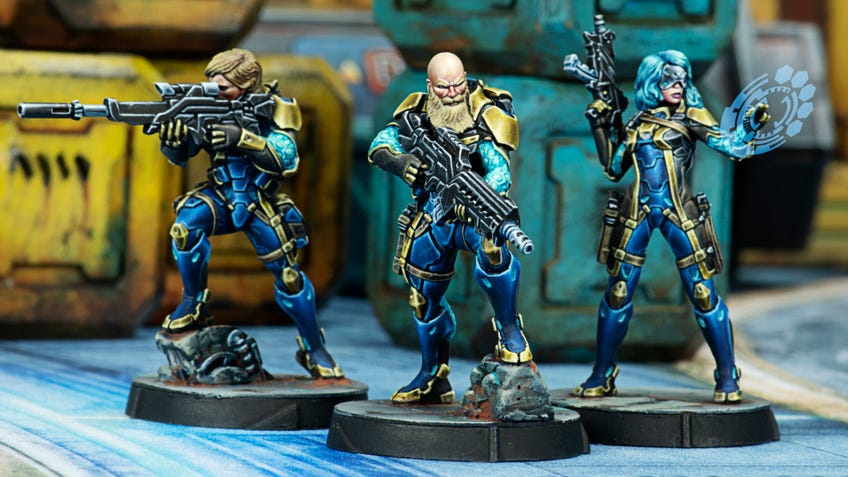9 best miniatures games that aren’t Warhammer
Wargaming without the battle.
Miniature wargaming is far and away one of the most intimidating aspects of the tabletop gaming hobby, especially for newcomers. At least part of that likely comes from the image it has of being dominated by the vast fantasy and sci-fi worlds of Warhammer. But Games Workshop’s behemoth isn’t the be-all and end-all of wargaming - many of the best miniatures games are simply less widely-known than 40K or Age of Sigmar.
Still, odds are that if you’re even a casual gamer, you’ve probably heard of Warhammer 40,000, Age of Sigmar or Fantasy Battle. In the same way that Dungeons & Dragons has become the pinnacle of all tabletop RPGs in the public’s eyes, Warhammer has a terminator’s iron grip on the mainstream perception of miniatures games.
Best tabletop miniatures games
- Malifaux
- Infinity
- Guild Ball
- Dreadball
- Star Wars: Legion
- The Walking Dead: All Out War
- A Song of Ice and Fire: Tabletop Miniatures Game
- Frostgrave
- Gaslands: Refuelled
If you’ve not already felt tempted to get into the many, many different Warhammer games and spin-offs on offer - or even if you tried and fell at the first hurdle - it simply might not be the game for you. Whether it’s the theme, the miniatures, the sheer amount of models required to play or the rules that you play by, Warhammer just isn’t for everyone - and that includes those who have been playing it for so long that they’re looking for a new horizon to explore or a new army to build.
With that in mind, here are our recommendations for the best miniatures games you can play right now that aren’t Warhammer.
1. Malifaux
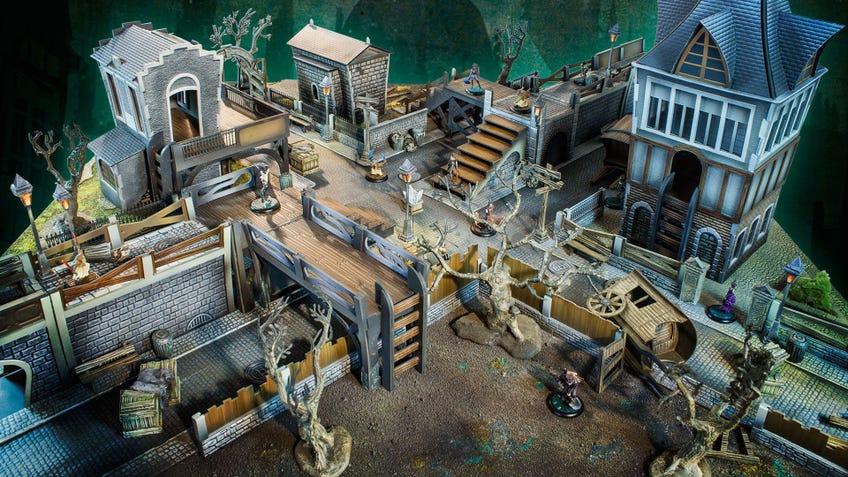
Malifaux sets its conflicts in a strange and deadly alternate-1900s Earth of the same name, full of horrible monsters, even more horrible people and a slew of ghosts, steampunk constructs and goblins. If you’re at all excited by the dark world of RPG Blades in the Dark - a Dicebreaker favourite - then this should certainly be a world to grab your attention. You could quite conceivably be leading a swamp hag into battle, surrounded by moss-covered, gatling gun-wielding, clockwork robots. On the other side of the table, a gang of Japanese-inspired ghosts and deadly spirits.
Malifaux is incredibly evocative and comes with some interesting new takes on the miniature wargaming formula. Done away with are dice, favouring instead a deck of cards that determines one-on-one conflicts as well as the damage you do and the defenses you can put up. You’re able to hold a hand of ‘cheat’ cards throughout each round, allowing you to make sure important steps in combat go your way - for instance, by changing a 2 into that 12 you’ve been saving.
Malifaux is a skirmish game, which means that you’ll be using a very small model count. This makes it a lot cheaper to get into combat, as you’ll only need to assemble a 10-unit squad rather than a 200-model mega-army. Each model also becomes a lot more personal and important, as losing just one is a significant portion of your army gone for good.
Malifaux also features alternating activations. If you have played a large game of Warhammer you’ll know that sitting around for 30 minutes whilst your opponent murders you and you just sit and watch is not very fun. Alternating activation means that the simple act of choosing which model is going to take their action first becomes even more pivotal.
If you’re looking at getting into Malifaux then the barrier for entry, especially cost-wise, is pretty low. Do be warned, however, that the small and quite finicky models can be absolute hell to put together, especially for those new to the hobby. There are also some pretty different ideas in the rulebook that wargaming diehards might be blindsided by, as they go against tradition in a few different aspects.
Buy Malifaux on Amazon US or Amazon UK.
2. Infinity
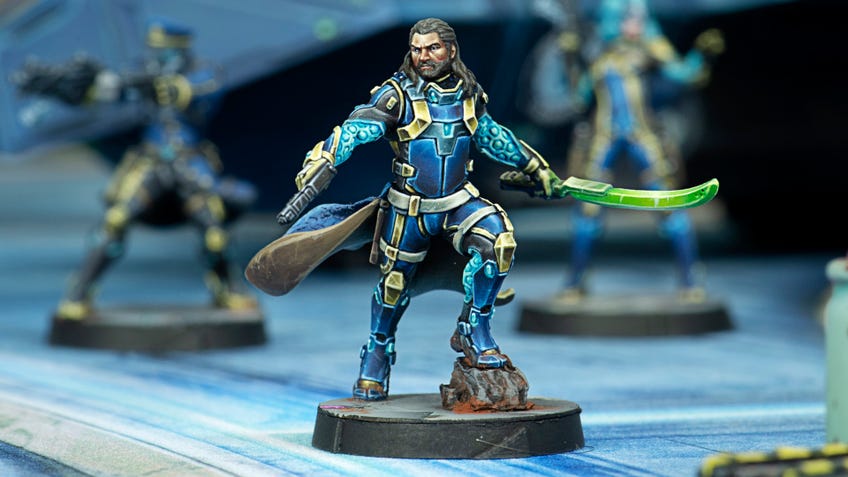
You might not know it from the cover art, but Infinity is set in our world - albeit 175 years into the future when humanity has reached the stars. All the major powers in the world have begun to stake their claim on the hospitable planets in the galaxy and many of the nation states that we know of today have combined forces to create new blocks of power, both on Earth and in the far reaches of space.
This setting allows for some amazing factions and subfactions for players to pick from when assembling their army. You might grab a set of the Panoceania space templars, the East-Asian conglomerate Yu Jing or even wield some kilt-clad, sword swinging Highlanders under the banner of Ariadna.
Infinity is definitely one of the more in-depth rulesets in this list, and probably one of the more complex ones to learn - although you can just grab a starter set and get to grips with the rules pretty gradually. Its complexity allows you to perform a massive amount of different tactics that reward players who stick to the rules. Your soldiers can go prone to avoid enemy fire, suppress choke points, and drop mines and smoke grenades to surprise their opponents. Giant mechs can be piloted and hacked, soldiers can wear stealth suits, and weapons have fire modes and effective ranges. Infinity brings breadth and depth by the bucketload and wraps it all in an incredibly stylish anime aesthetic. Clearly inspired by cultural touchstones such as Akira and Ghost in the Shell, you’ll be seeing gun-toting motorbike drivers, hackers, mechs, cloaking tech and invading alien empires all clashing on your table.
Mechanically, Infinity is really smart with some lovely rules that make for a smooth experience on the table. Like Malifaux, Infinity has low model counts, simulating squad tactics at a micro level rather than 100-model mass-combat scenarios. Each player rolls 20-sided dice whenever they perform an action such as shooting, dodging or healing. To succeed, you need a result lower or equal to the skill level of the soldier who’s attempting it, not unlike an RPG. The fun thing about Infinity is that, when attempting any of these actions within line-of-sight of an enemy, your opponent is able to react - meaning you’ll be doing just as much on your off turns as you are during your actual gos.
Buy Infinity from Zatu Games.
3. Guild Ball
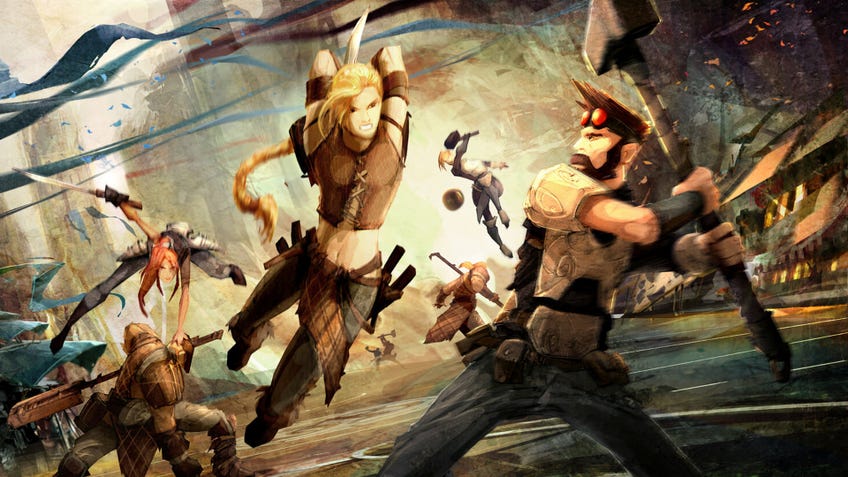
Gosh, there’s been a lot of war and fighting going on in those past couple of games, hasn’t there? If only we could put our differences aside and come together for some fun, carefree organised sporting events. And then punch each other to death at those instead.
Not all miniature wargaming is about amassing armies and seeing whose guns can pump out the most lead in a single turn. Miniatures sports games Dreadball and Guild Ball instead challenge you to best your opponent in a game of goals and tackles, laced with just a sprinkle of unfair play.
Guild Ball is by far the more popular of the two fantasy football titles. Set in a steampunk world, the players represent various guilds from across the cities of the world. It’s also more grounded than its competitor, using rulers and templates like a traditional wargame. There are rules for balls bouncing around the pitch, and you’ll have a stat line for things like how far you can kick the ball and how easily you can weather an attack. It’s definitely the more traditional of the two games, which may make it appealing to those with previous mini games experience.
If you’re a football fan - that’s real football, not the American imposter - you’ll be comfortable with the basic rules of the game and can go from there. You’re passing a ball around the pitch and trying to score in your opponent’s goal - the wackier elements are sprinkled on top. Guild Ball certainly has the nicer sculpts of the two options, as well with a gorgeous range of unique and interestingly-posed characters, along with thematic terrain and pitches you can buy to up the immersion.
Unfortunately, you might have to search around to find a set, as publisher Steamforged recently announced it was bringing an end to the game.
Buy Guild Ball on Amazon US or Amazon UK.
4. Dreadball
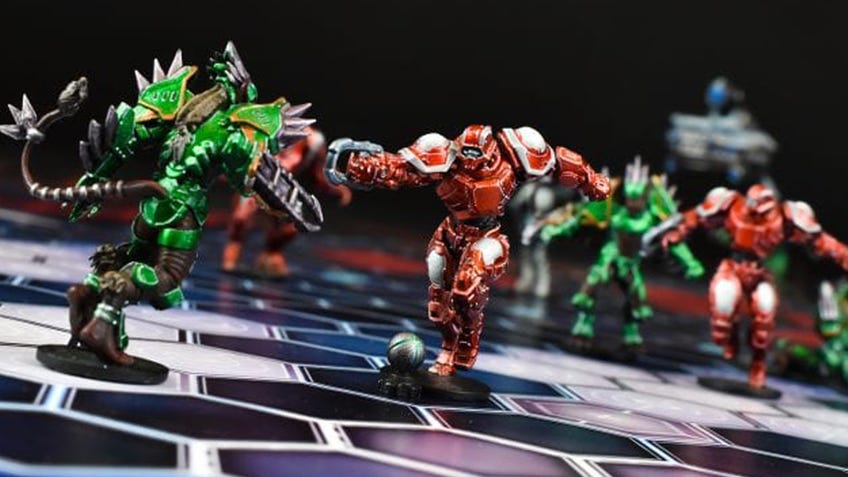
Dreadball, in comparison, is much more silly and lightweight. That doesn’t mean it’s necessarily easier or quicker to play, but where Guild Ball concerns itself with a true simulation of a fantasy version of the fantasy game, Dreadball is much more concerned with the bombast and drama of televised sporting events in the far-reaching, alien future of its sci-fi setting. In Dreadball you play through leagues and rile up the fans, and there’s a referee patrolling the pitch that you need to avoid when you’re committing blatant fouls on your opponents - just like in real sports.
The rulers and templates are replaced with a hex-based system, and instead of your standard football rules there are strike zone scoring areas that give you different point values depending on where you score from for a little risk-reward. You get everything you need to play Dreadball in a single box, and just go from there without having to worry about army compositions or how expensive your prospective team is to put together.
Whilst the models in Dreadball aren’t quite the same quality as those in Guild Ball, there’s a huge variety of sci-fi tropes and lookalikes from other games - including Warhammer spin-off Blood Bowl, which it clearly owes a lot of inspiration to. The smorgasboard of silly factions is lovely to pick from; each feels completely unique and absolutely true to the more comedic universe. The rulebook even includes a section on creating your own mutant team by combining lots of different body parts from other miniatures, which is a brilliant idea.
Buy Dreadball on Amazon US or Amazon UK.
5. Star Wars: Legion

For better or for worse, everyone knows Star Wars. So it was almost inevitable that a miniatures game set in a galaxy far, far away was going to find its way to tables of fans the world over. What people might not have realised is that we’d be getting three separate miniatures games that allow you to fight across land, air and sea - or, more accurately, land, space and big space. Where X-Wing specialises in close-quarters dogfights between ships and Armada focuses on massive fleet battles, Legion sticks its boots into the mud of ground combat.
If you’re looking for a wargame that’s very easy for new players to get into, Legion is the one to go with. It’s a very stripped-back system that gets rid of a lot of the guff that comes with some of the older and heavier systems out there. The core rules are incredibly slim and the models are easy to build. All of the stats for each unit fit onto a single standard-sized card and there are essentially just two factions to choose from: goodies or baddies. Gone are rulers and piles of d6s; instead, you’ll use eight-sided dice with symbols for success and failure and measuring sticks for moving your units in set blocks. It makes getting grips with the gameplay a real breeze, and it’s refreshingly quick and light to play.
Not to mention the fact that if you’re a Star Wars mega-fan you could grab three different sets from each of the three games and go from a galaxy-wide fleet battle in Armada to a one-on-one dogfight in X-Wing before touching down on the planet in Legion, with the outcome of each battle affecting the next.
Buy Star Wars: Legion on Amazon US or Amazon UK.
6. The Walking Dead: All Out War

Sometimes things get a little more spicy when you add an unknown extra ingredient. A bit of coffee in your chilli con carne, some Die Hard in your Christmas movie marathon or, in this case, some brain-hungry zombies in your tabletop miniatures game. The story of the Walking Dead exploded into popularity when the original graphic novels were adapted into a record-breaking TV series.
Everyone at some point in their lives has asked themselves what they’d do if they were in that classic zombie apocalypse scenario. The Walking Dead: All Out War gives you a pretty fun avenue to explore that. There are rules for attracting the dead, (or avoiding them) by cleverly using noise to redirect their attacks, pushing your luck between sneaking and sprinting, and scavenging post-apocalyptic scraps.
If you’re a fan of the series of graphic novels that spawned this big box of shambling corpses then you’ll find plenty of recognisable characters popping up here. The miniatures in the box are well-built and come pre-assembled, which is a good start for anyone new to painting. The sculpts themselves are a little bit stockier than your average human, but the exaggerated details will help with those who aren’t as experienced with the artistic side of the hobby.
All Out War isn’t exactly revolutionary but it does do some really fun and interesting things with its source material. The minis are nice, the available terrain is a good start for someone building up a table for modern settings and it all comes packed in a nicely stylish box. It also happens to be one of the few miniatures games that allows you to play solo, too.
If you’re looking for a quick and deadly game of undead dodging, then The Walking Dead: All Out War might just be the miniatures game for you.
Buy The Walking Dead: All Out War on Amazon US or Amazon UK.
7. A Song of Ice and Fire: Tabletop Miniatures Game
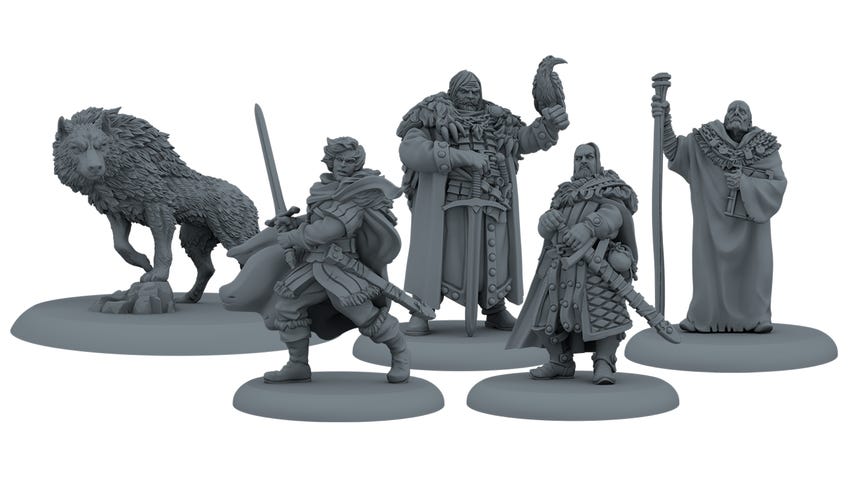
Most board games set in the seven kingdoms of Westeros focus on the dirty dealings, betrayal and blood-spilling away from the battlefield. They’re about dispatching your rivals with a knife slipped between the ribs, a poisoned goblet of wine or a crossbow to the nads while you swap the Iron Throne for a porcelain one.
But the A Song of Ice and Fire books and Game of Thrones TV show they inspired wouldn’t be the same without the occasional big ol’ battle and bloodshed en masse. That’s where this sweeping miniatures game steps in, bringing the action down to the grunts at the frontline of each house as they clash swords, spears and deep-rooted philosophical differences - resolved, like all complex discussions, by chopping each other into itty-bitty pieces.
To get across the sense of commanding a vast, highly-trained army belonging to the Starks, Lannisters or whoever you decide to throw your lot in with, the Song of Ice and Fire: Tabletop Miniatures Game uses what’s called a rank-and-file system. Instead of moving individual models as in skirmish games like Warhammer 40,000, your models sit on plastic trays that keep them tightly arranged in pleasingly neat rows and columns. Manoeuvring trays makes for a distinctly different style of play compared to the nimble single troops and flexible gangs in skirmish games.
While the game’s enlarged scope comes from scores of anonymous troops being whittled down to nothing, the characters you know from the books and TV show also play a key role. Leaders can be assigned to particular units, lending their personality and special abilities to the frontline - you might have the fast striking ability of Robb Stark and his direwolf Grey Wind, or the slower but formidable might of The Mountain, or someone in-between.
Characters not as at home on the bloodsoaked battlefield aren’t left out of the action, either. Familiar faces that favour brains over brawn, such as Tyrion and Sansa, compete over a separate board that represents the political machinations behind the scenes - granting each side extra powers and advantages. You might be able to erode enemy troops’ morale - making them more likely to suffer losses in combat - or boost your own units’ resolve. It makes the whole thing stay true to the world of Westeros, while also giving battles a slightly different feel and flow to more cut-and-dried murderfests. (That said, with over 100 minis in the starter box, you’ll still be slaughtering unfortunate soldiers by the dozen.)
A Song of Ice and Fire is a different kind of Game of Thrones game, and a different kind of miniatures game, compared to what’s out there. Despite the well-known world it’s attached to, its combination of board and miniatures gaming means it’s likely to be more of a cult choice when it comes to finding nearby wargaming clubs and local opponents interested in playing. But as far as getting started with miniatures games goes, everything you need is in the box and you’re likely to already be familiar with the lore - making this a decent first step into a brave new world.
Buy A Song of Ice and Fire: Tabletop Miniatures Game on Amazon US or Amazon UK.
8. Frostgrave

In this bombastic miniatures game - affectionately called Tuesday Night Wizard Fight by my friends - each player gets a certain amount of gold to assemble a warband before taking to the eponymous frozen city of Frostgrave. They have to purchase a wizard and a wizard’s apprentice, then they can spend the gold as they see fit to hire mercenaries to their cause. Units like knights are durable heavy-hitters and thus cost a bit more, but you can also hire archers, thieves, crossbowmen and even dogs.
Once you’ve chosen your wizard, you then select one of ten schools of magic and choose some spells. You might be a summoner, for example, raising demons and attempting to bind them to your will. You might be a sigilist, setting deadly traps - although frankly it’s not recommended that unless you plan on having a really rubbish game - or you might even be a morally dubious necromancer.
So far, so Earthsea, but this is where all the noble traditions of magic and the dignity of being a scholarly wizard go right out the castle window. In your average game of Frostgrave, there are a series of treasure markers. The game is a mad dash to grab those treasure markers and ferry them to the edge of the board, killing off your opponents as you go in order to see who can gather the most experience points and loot. It’s basically the sword-carrying equivalent of someone throwing a bunch of gold in the air in a tavern in order to start a bar fight.
The combat runs off a simple d20 system so it’s not hard to pick up, and your magic users have the option of taking wounds in order to make up for a bad roll so, if you’re desperate to cast a spell, you can push your wizard or apprentice right to the brink of death to make it happen.
Hands down the best thing about Frostgrave is that it’s an extremely cheap game to buy into. The core rulebook, which is all you need to get started, will set you back about fifteen quid at the most. You can also use whatever models you like - even plastic toy soldiers will do - although it’s worth noting that ranged attacks work on line-of-sight in this game, so don’t go for full-size action figures.
If you want to use official Frostgrave miniatures they’re also quite affordable, but a random mishmash is a great way to lean into the chaotic energy that personifies this game. It’s fast, it’s well-suited to campaign play and, best of all, it is very, very silly.
Buy Frostgrave on Amazon US or Amazon UK.
9. Gaslands: Refuelled
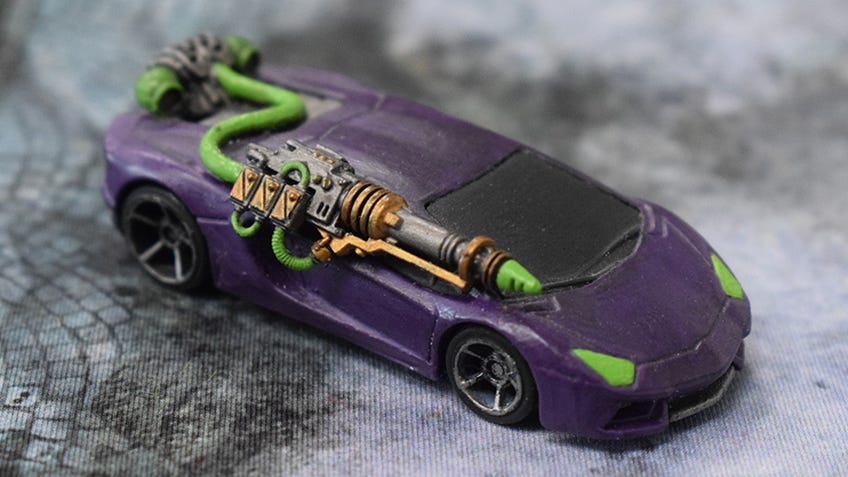
If you manage to watch any of the Mad Max films without immediately wanting to strap a flamethrower onto the bonnet of your Peugeot 108 and spray silver food colouring over your mouth then I’m not saying there’s something wrong with you, but you’ll definitely be less excited by the premise of Gaslands: Refuelled than I am.
Gaslands is a ruleset for playing wargames with matchbox cars such as Hot Wheels - or whatever toy cars you can find in a pound shop. You’ll use a points system to assemble a squadron of battle-ready bangers, complete with crew members and welded-on weapons. Gaslands uses a template system that you might be familiar with from games such as X-Wing, in which you’ll place a car at the start of a movement template and then move it to the end to simulate a manoeuvre. Each of your vehicles will be set to a gear, determining how fast it can travel in exchange for manoeuvrability. The higher the gear you’re in, the faster you’ll be able to travel across the board and the more damage you’ll do when you smash into the side of another vehicle.
The biggest obstacle for getting into Gaslands is that the only official real resource that exists for it is the rulebook itself. There are no official models, no kits for upgrading cars, no tokens or templates. The flipside of this is that if you want to give Gaslands a go, and have some toy cars and dice lying around, all you really need is the rulebook and a printer. Templates can be cut from paper and stuck onto cardboard, all the special dice can be rolled as a standard d6 using a table and you don’t have to do a single bit of painting if you’re not fussed about visuals. This makes Gaslands incredibly cheap to get into, absurdly so.
If you want to play a miniatures game that’s truly unique from the standard laser guns and swords, Gaslands is a must, with all kinds of fun bonus rules for elements such as crowd interaction, campaigns, driver experience and levelling up, tanks and helicopters, and pretty much anything you want to add in.
Whether it’s a destruction derby, Mario Kart-style racing or protecting a massive war rig that you’re escorting across a barren desert, there’s lots to love in this gas-guzzling, budget miniatures game.
